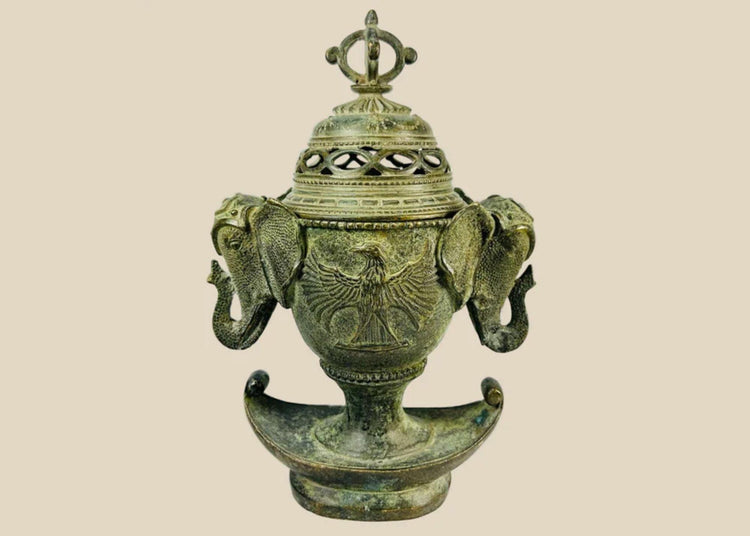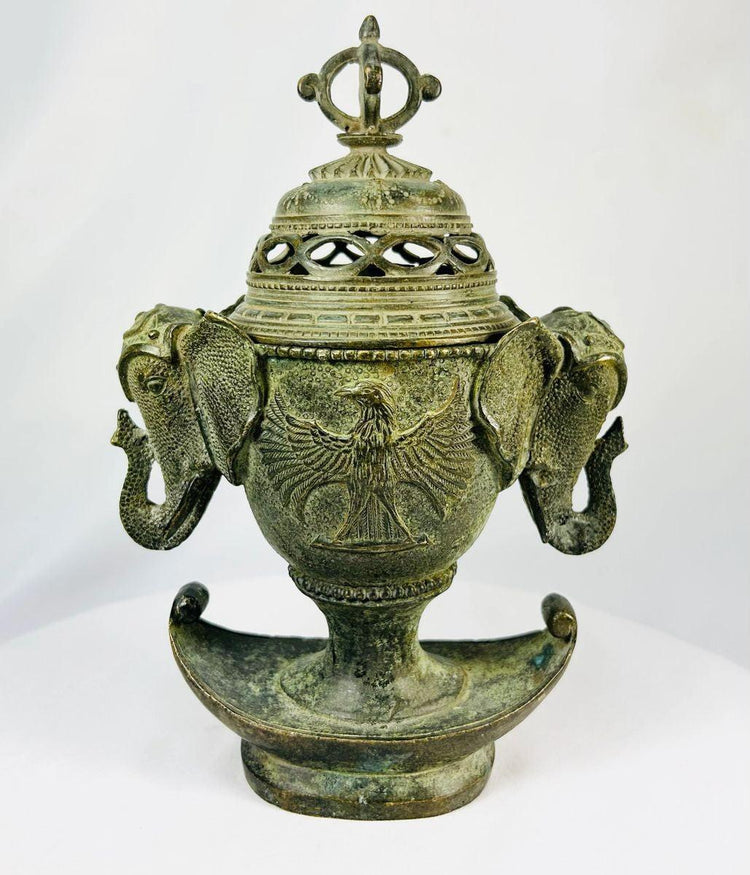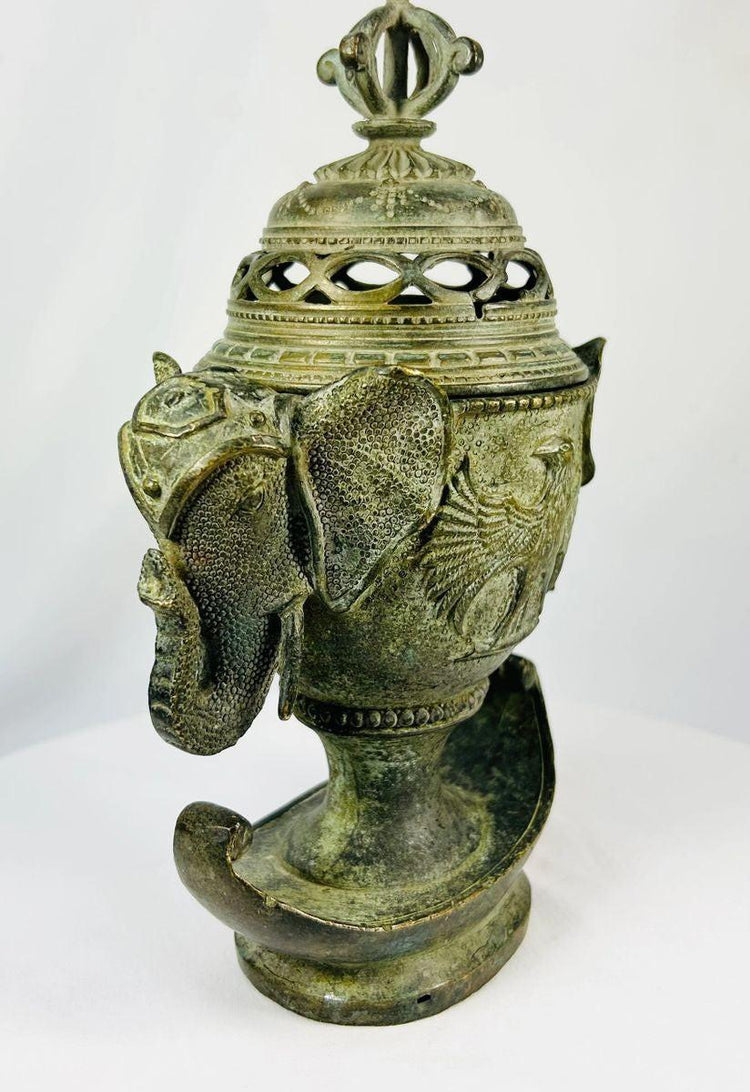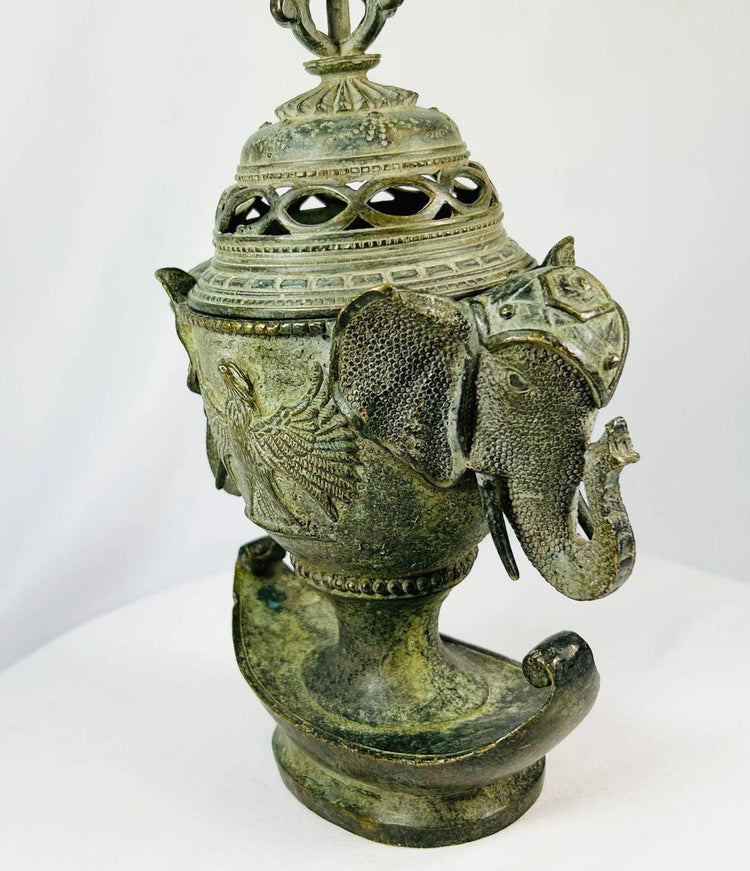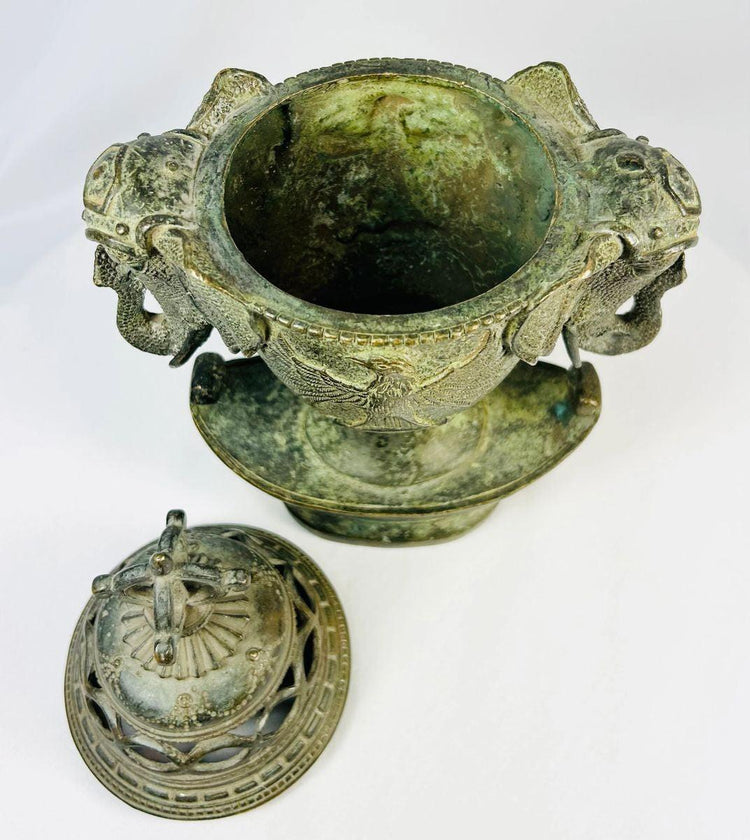Qing Dynasty | Bronze Censer | Twin Elephants & Vajra Finial | 18th Century
Description
More
Less
Historical Context & Origin
Region: China / Tibet (Qing Imperial influence)
Material: Cast bronze with traces of gilt finish and natural verdigris patina
Period: Qing Dynasty, circa 18th – early 19th century
Description
This highly unusual and decorative Qing Dynasty incense burner features twin elephant-head handles, each finely stippled for texture, flanking a vessel body adorned with stylized phoenix (fenghuang) motifs in relief. The pierced, domed lid is crowned by a Buddhist vajra finial, symbolizing spiritual power and ritual protection. The burner rests on a distinctive crescent-shaped foot base decorated with scrolling wave patterns, combining Chinese and Tibetan design elements in a harmonious, ceremonial form. The piece exemplifies the blending of religious symbolism and artistry typical of high-quality Qing-era devotional or noble household objects.
Features
- Twin elephant-head handles with textured detail
- Relief decoration of phoenix (fenghuang) motifs on body
- Pierced openwork domed lid topped with vajra finial
- Crescent-shaped base with scroll ornamentation
- Original surface patina with traces of gilding
Cultural Significance
Elephants are powerful symbols of wisdom, strength, and stability across both Chinese and Tibetan traditions, while the phoenix embodies renewal, prosperity, and auspicious fortune. The addition of the vajra finial emphasizes the object’s ritual function within Buddhist ceremonial contexts. Such censers were likely used in temples or noble residences, where incense offerings played a vital role in purification, meditation, and devotional practices.
Condition
Very good antique condition. Rich natural patina with areas of oxidation, minor gilt loss, and surface wear consistent with age and ritual use. No major losses or restorations. Lid fits securely.
Dimensions (approximate)
Height: 10 in
Age
Estimated 200–250 years old (Qing Dynasty, circa 18th – early 19th century)
Learn More
Explore a comparable Qing Dynasty bronze incense burner in a major museum collection:
Qing Dynasty Bronze Censer – The Metropolitan Museum of Art
Browse additional imperial-era bronzes, ritual vessels, and ancient Chinese artifacts in our curated collection: Ancient Chinese Artifacts & Imperial Relics – Relic And Rarity
Description
Historical Context & Origin
Region: China / Tibet (Qing Imperial influence)
Material: Cast bronze with traces of gilt finish and natural verdigris patina
Period: Qing Dynasty, circa 18th – early 19th century
Description
This highly unusual and decorative Qing Dynasty incense burner features twin elephant-head handles, each finely stippled for texture, flanking a vessel body adorned with stylized phoenix (fenghuang) motifs in relief. The pierced, domed lid is crowned by a Buddhist vajra finial, symbolizing spiritual power and ritual protection. The burner rests on a distinctive crescent-shaped foot base decorated with scrolling wave patterns, combining Chinese and Tibetan design elements in a harmonious, ceremonial form. The piece exemplifies the blending of religious symbolism and artistry typical of high-quality Qing-era devotional or noble household objects.
Features
- Twin elephant-head handles with textured detail
- Relief decoration of phoenix (fenghuang) motifs on body
- Pierced openwork domed lid topped with vajra finial
- Crescent-shaped base with scroll ornamentation
- Original surface patina with traces of gilding
Cultural Significance
Elephants are powerful symbols of wisdom, strength, and stability across both Chinese and Tibetan traditions, while the phoenix embodies renewal, prosperity, and auspicious fortune. The addition of the vajra finial emphasizes the object’s ritual function within Buddhist ceremonial contexts. Such censers were likely used in temples or noble residences, where incense offerings played a vital role in purification, meditation, and devotional practices.
Condition
Very good antique condition. Rich natural patina with areas of oxidation, minor gilt loss, and surface wear consistent with age and ritual use. No major losses or restorations. Lid fits securely.
Dimensions (approximate)
Height: 10 in
Age
Estimated 200–250 years old (Qing Dynasty, circa 18th – early 19th century)
Learn More
Explore a comparable Qing Dynasty bronze incense burner in a major museum collection:
Qing Dynasty Bronze Censer – The Metropolitan Museum of Art
Browse additional imperial-era bronzes, ritual vessels, and ancient Chinese artifacts in our curated collection: Ancient Chinese Artifacts & Imperial Relics – Relic And Rarity
You May Also Like




















